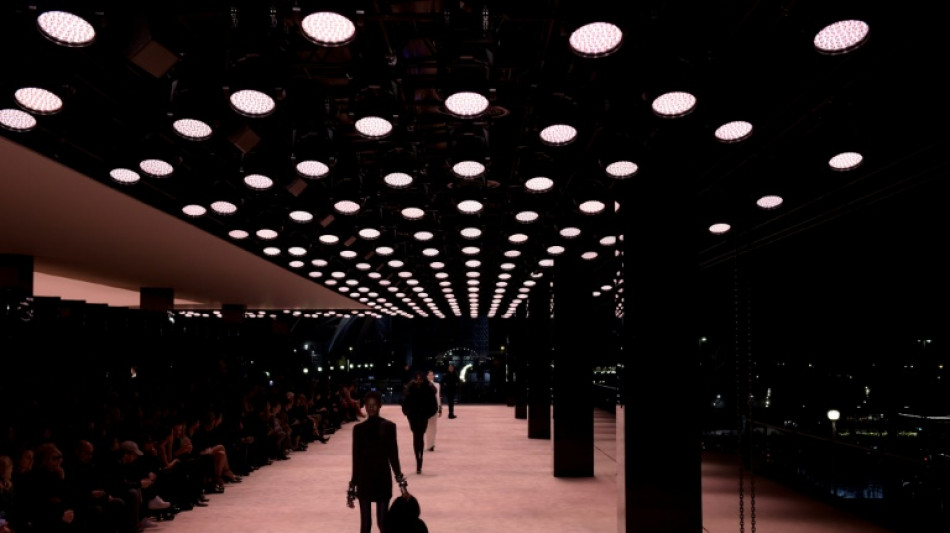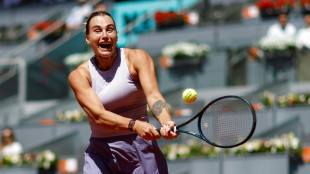
-
 Indian army says new exchange of gunfire with Pakistan
Indian army says new exchange of gunfire with Pakistan
-
Epstein accuser Virginia Giuffre takes own life in Australia: family

-
 Hundreds of buildings damaged, dozens injured in 6.3 Ecuador quake
Hundreds of buildings damaged, dozens injured in 6.3 Ecuador quake
-
India and Pakistan's Kashmir fallout hits economy too

-
 Francis's funeral to be grand farewell to 'pope of the poor'
Francis's funeral to be grand farewell to 'pope of the poor'
-
Pogacar faces defiant Evenepoel at Liege-Bastogne-Liege

-
 Chelsea eye great escape against Barcelona in Women's Champions League
Chelsea eye great escape against Barcelona in Women's Champions League
-
Iran, US to hold new round of high-level nuclear talks

-
 'Energy and effort' pay off for Reds as Blues' woes continue
'Energy and effort' pay off for Reds as Blues' woes continue
-
Albatross and closing birdie lift China's Liu to LPGA Chevron lead

-
 On the horizon? Wave of momentum for high seas treaty
On the horizon? Wave of momentum for high seas treaty
-
Developing countries should fast-track US trade deals: World Bank president

-
 Grizzlies' Morant 'doubtful' for must-win game 4 v Thunder
Grizzlies' Morant 'doubtful' for must-win game 4 v Thunder
-
Trump in Rome for pope funeral in first foreign trip of new term

-
 Trump says Russia-Ukraine deal 'very close' after new Kremlin talks
Trump says Russia-Ukraine deal 'very close' after new Kremlin talks
-
US rookies lead PGA pairs event with McIlroy and Lowry in hunt

-
 Trump tariff promises get a reality check
Trump tariff promises get a reality check
-
Warriors coach Kerr 'relatively optimistic' injured Butler will play game 3

-
 Postecoglou hopes 'Stonecutter's Credo' can inspire Spurs
Postecoglou hopes 'Stonecutter's Credo' can inspire Spurs
-
PSG lose unbeaten Ligue 1 record ahead of Arsenal showdown

-
 Venezuela accuses El Salvador president of 'human trafficking'
Venezuela accuses El Salvador president of 'human trafficking'
-
Own goal takes Sundowns to African final against Pyramids

-
 Scores of buildings damaged, 20 injured in Ecuador quake
Scores of buildings damaged, 20 injured in Ecuador quake
-
US stocks extend rally as market eyes busy calendar next week

-
 Pope's death triggers surge of disinformation he fought against
Pope's death triggers surge of disinformation he fought against
-
Rovanpera takes control of Rally Islas Canarias

-
 Zelensky insists Crimea is Ukrainian as US envoy meets Putin
Zelensky insists Crimea is Ukrainian as US envoy meets Putin
-
Patel and Mendis help Sunrisers beat Kings in Dhoni's 400th T20

-
 Copa del Rey ref statements 'unacceptable': Real Madrid after boycotting final build-up
Copa del Rey ref statements 'unacceptable': Real Madrid after boycotting final build-up
-
Insurance CEO's accused killer pleads not guilty to federal murder charges

-
 FBI arrests Wisconsin judge for shielding undocumented migrant
FBI arrests Wisconsin judge for shielding undocumented migrant
-
Brazil ex-president Collor de Mello jailed for corruption

-
 Zelensky insists Crimea 'belongs' to Ukraine as US envoy meets Putin
Zelensky insists Crimea 'belongs' to Ukraine as US envoy meets Putin
-
Real Madrid boycott Copa del Rey build-up over referee complaints

-
 Trinidad and Tobago votes for parliament, PM, with opposition in lead
Trinidad and Tobago votes for parliament, PM, with opposition in lead
-
IMF chief hails 'constructive' Spring Meetings held under tariff uncertainty

-
 Iran FM Araghchi in Oman ahead of nuclear talks with US
Iran FM Araghchi in Oman ahead of nuclear talks with US
-
Dozens of buildings destroyed, 20 injured in Ecuador quake

-
 Young Barca must 'enjoy' Real Madrid Copa final fight: Flick
Young Barca must 'enjoy' Real Madrid Copa final fight: Flick
-
Pakistan and India border closure separates families

-
 Brazil's Bolsonaro 'stable' after post-surgery setback
Brazil's Bolsonaro 'stable' after post-surgery setback
-
Catholics in secular Cuba hail Francis as 'bridge'

-
 US envoy Witkoff, Putin discuss 'possibility' of direct Russia-Ukraine talks
US envoy Witkoff, Putin discuss 'possibility' of direct Russia-Ukraine talks
-
Community seeks answers after French school knife killing

-
 German prosecutors seek jail terms in VW 'dieselgate' trial
German prosecutors seek jail terms in VW 'dieselgate' trial
-
Sabalenka makes winning start at Madrid Open

-
 EU, US should de-escalate and negotiate trade deal: IMF Europe director
EU, US should de-escalate and negotiate trade deal: IMF Europe director
-
Russia accuses Ukraine of killing general in car bombing

-
 Emery wants FA Cup glory and Champions League berth for Villa
Emery wants FA Cup glory and Champions League berth for Villa
-
Buildings destroyed, one injured in Ecuador quake


The 'tyranny of thinness' still dominates fashion
Despite claims that the fashion industry is embracing curvier bodies, the data suggests it could be guilty of what one expert calls "fat-washing".
While a handful of plus-size models such as Paloma Elsesser have grabbed media attention in recent years, the figures shows they remain a vanishingly small minority.
Vogue Business looked at 9,137 outfits unveiled during 219 shows in New York, London, Milan and Paris last season and found that 0.6 percent were plus-size -- defined as US size 14 or above, which is actually the average size for a woman in the United States -- and only 3.8 percent were size 6-12.
This means 95.6 percent of outfits presented were in US size 0-4.
Paolo Volonte, who teaches sociology of fashion in Milan, says brands use a few curvy models to deflect criticism.
"It's 'fat-washing'," he told AFP, comparing it to criticisms of cynical "green-washing" by which the industry is accused of making empty climate pledges.
"They use curvy models in their shows to show inclusivity but in fact this is to preserve and maintain a system based on the tyranny of the thin ideal," Volonte said.
Ekaterina Ozhiganova, a 20-year-old model and law student, says luxury brands simply "refuse to represent normal people".
Medium-sized women "are often told either to lose weight... or to push themselves up to XL," she told AFP. "Neither is healthy."
- 'Darling, that's the job' -
Ozhiganova's advocacy group, Model Law, carried out a survey that found nine out of 10 models felt pressure to change their bodies, more than half on a regular basis.
"It's very hard for them to talk about," she said. "If you complain, everyone will just say: 'Darling, that's the job.'"
How it became "the job" is a question of history.
Volonte says the obsession with thinness dates back to the birth of industrial production techniques.
Previously, designers made clothes specific to individuals. In the mass production era, they use small templates which they scale up for larger sizes.
This only works up to a certain size, however, after which fat and muscle can change the shape of bodies in more complex ways.
"It is much more expensive to produce and sell clothing on higher sizes and requires more expertise," said Volonte.
At the same time, thinness became firmly associated with wealth -- having the time and money to work on your body -- an aspiration that has been deeply entrenched by advertising and the day-to-day practices of the fashion industry.
- 'A fantasy world' -
There have been efforts to change things since the early 2000s when fears spread that size-zero models were encouraging anorexia in young people.
Since 2017, France requires models to pass medical examinations, while the country's two biggest luxury conglomerates, LVMH and Kering, signed charters vowing to stop using size-zero models.
But with sizes varying from one brand to the next, this is hard to enforce.
Designers are as trapped in the status quo as everyone else.
Elite couturier Mohammad Ashi says discrimination based on race and gender has been fairly well tackled in fashion, but shape is tricky.
"We're not trying to avoid it, but from an industrial point of view, we can't produce a plus-size dress. We sell what we show and I know our clients personally. It's just business," he told AFP.
Couturier Julien Fournie has used pregnant models and his favourite model, Michaela Tomanova, has "six centimetres everywhere more than the others".
But he says, "fashion remains fashion... It's a fantasy world and that will never change fundamentally."
O.Johnson--AMWN


